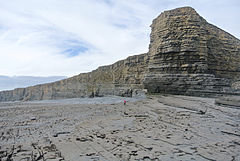| Blue Lias Formation | |
|---|---|
| Stratigraphic range: Rhaetian-Lower Sinemurian Planorbis-Semicostatum ~ | |
 Lower Lias sequence exposed at Nash Point, Glamorgan, Wales | |
| Type | Geological formation |
| Unit of | Lias Group |
| Sub-units | Wilmcote Limestone Member, Saltford Shale Member, Rugby Limestone Member |
| Underlies | Charmouth Mudstone Formation |
| Overlies | Lilstock Formation |
| Thickness | up to 120 metres (390 ft) |
| Lithology | |
| Primary | Limestone |
| Other | Mudstone |
| Location | |
| Region | Europe |
| Country | United Kingdom |
| Extent | South West England, Wales |
| Type section | |
| Location | Saltford railway cutting |
The Blue Lias is a geological formation in southern, eastern and western England and parts of South Wales, part of the Lias Group. The Blue Lias consists of a sequence of limestone and shale layers, laid down in latest Triassic and early Jurassic times, between 195 and 200 million years ago. The Blue Lias is famous for its fossils, especially ammonites.
Its age corresponds to the Rhaetian to lower Sinemurian stages of the geological timescale, thus fully including the Hettangian stage. It is the lowest of the three divisions of the Lower Jurassic period and, as such, is also given the name Lower Lias. Stratigraphically it can be subdivided into three members: the Wilmcote Limestone, Saltford Shale and Rugby Limestone.[1]
- ^ Ambrose, K.; 2001: The lithostratigraphy of the Blue Lias Formation (Late Rhaetian–Early Sinemurian) in the southern part of the English Midlands Archived 7 March 2006 at the Wayback Machine, Proceedings of the Geologists' Association 112(2), pp. 97-110.